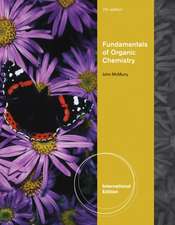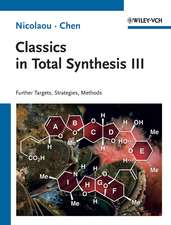Reactions of Sulfur with Organic Compounds
Autor E.N. Deryagina, A.S. Nakhmanovich, V.A. Usov, Mikhail Grigor'evich Voronkov, N.S. Vyazankinen Limba Engleză Paperback – 17 feb 2012
Preț: 402.98 lei
Nou
Puncte Express: 604
Preț estimativ în valută:
77.12€ • 79.90$ • 64.36£
77.12€ • 79.90$ • 64.36£
Carte tipărită la comandă
Livrare economică 21 martie-04 aprilie
Preluare comenzi: 021 569.72.76
Specificații
ISBN-13: 9781468406818
ISBN-10: 1468406817
Pagini: 444
Ilustrații: 440 p.
Dimensiuni: 178 x 254 x 29 mm
Greutate: 0.77 kg
Ediția:Softcover reprint of the original 1st ed. 1987
Editura: Springer Us
Colecția Springer
Locul publicării:New York, NY, United States
ISBN-10: 1468406817
Pagini: 444
Ilustrații: 440 p.
Dimensiuni: 178 x 254 x 29 mm
Greutate: 0.77 kg
Ediția:Softcover reprint of the original 1st ed. 1987
Editura: Springer Us
Colecția Springer
Locul publicării:New York, NY, United States
Public țintă
ResearchDescriere
This book, written by the eminent Russian organic chemist Professor M. G. Voronkov, exhaustively deals with the reactions of sulfur with organic compounds. It is the only book on the subject which covers both work readily available to Western scientists and research carried out by Russian workers. Since much of the work discussed in this volume is not readily accessible to Western scien tists, it will enable them to find hitherto "unpublished" research. In addition, Professor Voronkov has dealt with many reactions and processes of interest to the industrial chemist; e.g., there is an interesting section on sulfur dyes and related compounds, and the chemistry of vulcanization is lucidly discussed. Hence this book should be of value to both academic and industrial chemists inter ested in the chemistry and reactions of sulfur, and also to those synthetic chemists studying new pathways to organic compounds. The text has recently been updated and revised, and there are numerous references to publications up to and including 1980. An exhaustive index is provided to enable the reader to refer rapidly to any of the compounds, reactions, or processes discussed in the text.
Cuprins
1 Structure and Physical Properties of Elemental Sulfur.- 1.1 Atomic and Molecular Structure.- 1.2 Allotropic Modifications.- 1.3 Physical Properties.- 1.3.1 The Solid State.- 1.3.2 The Liquid State.- 1.3.3 The Gaseous State.- 1.4 Solubility.- References.- 2 Methods of Preparation and Chemical Properties of Different Modifications of Sulfur.- 2.1 Monatomic Sulfur.- 2.2 Diatomic Sulfur.- 2.3 Oligo- and Polyatomic Sulfur.- 2.4 Reactions of Sulfur in Aqueous Media.- 2.5 Reactions of Elemental Sulfur in Liquid Ammonia and with Amines.- 2.6 Catalysis of Chemical Reactions of Sulfur.- References.- 3 The Action of Sulfur upon Hydrocarbons.- 3.1 Alkanes.- 3.1.1 Methane and the Lower Alkanes.- 3.1.2 Higher Alkanes.- 3.1.3 Preparation of Hydrogen Sulfide from Hydrocarbons.- 3.1.4 Preparation of Carbon Disulfide.- 3.2 Alkenes.- 3.2.1 Ethylene.- 3.2.2 High Alkenes.- 3.3 The Willgerodt Reaction.- 3.4 Alkadienes and Alkapolyenes.- 3.5 Vulcanization.- 3.6 Alkynes.- 3.7 Cycloalkanes and their Aromatic Derivatives.- 3.8 Cycloalkenes.- 3.9 Terpenes and Terpenoids.- 3.10 Aromatic Hydrocarbons.- 3.11 Arylaliphatic Hydrocarbons.- 3.11.1 Arylalkanes.- 3.11.2 Arylalkenes and Arylalkadienes.- References.- 4 Organic Halides.- 4.1 Alkyl Halides.- 4.2 Halosubstituted Alkenes and Alkadienes.- 4.3 Halosubstituted Alkynes.- 4.4 Halosubstituted Cycloalkanes.- 4.5 Halo-Derivatives of Benzene, Naphthalene, and Anthracene.- 4.6 2-Halotoluenes.- 4.7 Aryl Substituted Haloalkanes.- 4.7.1 Aryl Substituted Halomethanes.- 4.7.2 Side-Chain Halo-Derivatives of Ethylbenzene and Styrene.- 4.7.3 ?- or ?-Halo-Derivatives of Di-, Tri-, and Tetraphenylethane.- 4.7.4 ?-, ?-, and ?-Halo-Derivatives of Mono-, Di-, and Tetraphenylpropane.- 4.8 Halo-Derivatives of Heterocyclic Compounds.- 4.9 The Mechanism of the Interaction of Sulfur with Hydrocarbons and their Halosubstituted Derivatives.- References.- 5 Organic Sulfur Compounds.- 5.1 Thiols.- 5.2 Sulfides and Polysulfides.- 5.3 Sulfoxides, Sulfones, Sulfonic Acids and their Derivatives.- 5.4 Thiocarbonyl Compounds.- 5.5 Sulfur-Containing Heterocyclic Compounds.- References.- 6 Oxygen-Containing Compounds.- 6.1 Compounds with a Hydroxyl Group.- 6.1.1 Aliphatic Alcohols.- 6.1.2 Arylaliphatic Alcohols.- 6.1.3 Polyhydroxy-Alcohols and Saccharides.- 6.1.4 Cycloaliphatic Alcohols.- 6.1.5 Phenol and its Derivatives.- 6.2 Ethers.- 6.3 Aldehydes.- 6.4 The Reaction of Sulfur with Aldehydes in the Presence of Ammonia or Amines.- 6.5 Ketones.- 6.6 The Simultaneous Interaction of Elemental Sulfur and Ammonia with Ketones.- 6.7 The Reaction of Ketones with Sulfur and Amines (The Kindler Reaction).- 6.8 The Interaction of Sulfur and Ammonia or Amines with Carbon Monoxide.- 6.9 Carboxylic Acids.- 6.9.1 Alkane-, Arylalkane- and Cycloalkane-carboxylic Acids.- 6.9.2 Unsaturated Acids.- 6.9.3 Aromatic Carboxylic Acids.- 6.10 Esters.- 6.10.1 Esters of Saturated Carboxylic Acids.- 6.10.2 Esters of Unsaturated Carboxylic Acids.- 6.10.3 Fatty Oils.- References.- 7 Nitrogen-Containing Compounds.- 7.1 Aliphatic and Arylaliphatic Amines.- 7.1.1 Primary Amines.- 7.1.2 Secondary Amines.- 7.1.3 Tertiary Amines.- 7.1.4 ?,?-Unsaturated Amines (Enamines).- 7.2 Aromatic Amines.- 7.2.1 Primary Amines.- 7.2.2 Secondary Amines.- 7.2.3 Tertiary Amines.- 7.3 Imines and Oximes.- 7.4 Amides and Thiocarboxamides.- 7.5 Carbamic Acid, Thiourea, and Guanidine Derivatives.- 7.6 Nitriles.- 7.7 Isonitriles and Isothiocyanates.- 7.8 Diazo-Compounds and Azides.- 7.9 N-Halosubstituted Derivatives.- 7.10 Nitro-Compounds.- 7.11 Nitrogen-Containing Heterocyclic Compounds.- 7.12 Sulfur Dyes Based on the Reaction of Organic Compounds with Sulfur.- 7.12.1 Synthesis of Sulfur Dyes.- 7.12.2 Properties of Sulfur Dyes.- 7.12.3 Structure of Sulfur Dyes.- 7.12.4 Individual Sulfur Dyes.- 7.12.5 Some Sulfur-Containing Dyes.- References.- 8 Reactions of Sulfur with Organometallic Compounds.- 8.1 Organic Derivatives of the Alkali Metals.- 8.2 Organic Compounds of Copper and Silver.- 8.3 Organomagnesium Compounds.- 8.4 Organic Derivatives of Zinc, Cadmium, and Mercury.- 8.5 Organic Derivatives of the Boron Subgroup Elements.- 8.6 Organic Derivatives of the Silicon Subgroup Elements.- 8.7 Organic Derivatives of the Phosphorus Subgroup Elements.- 8.8 Organic Derivatives of Selenium and Tellurium.- 8.9 Organic Derivatives of the Transition Metals.- References.










